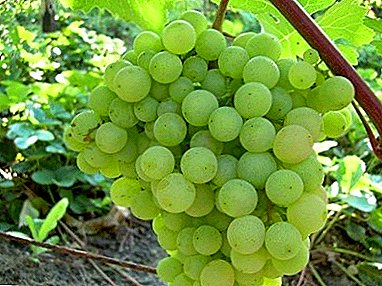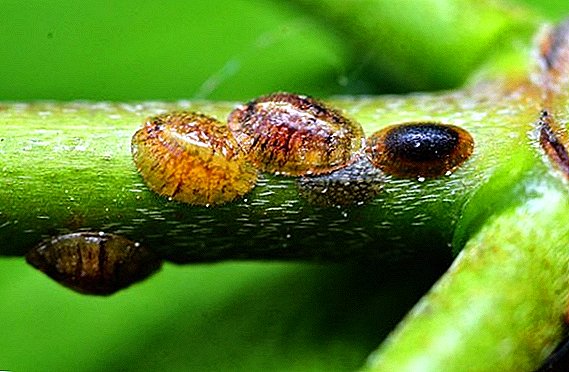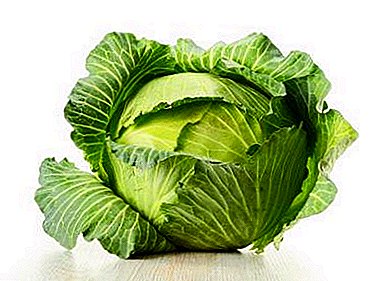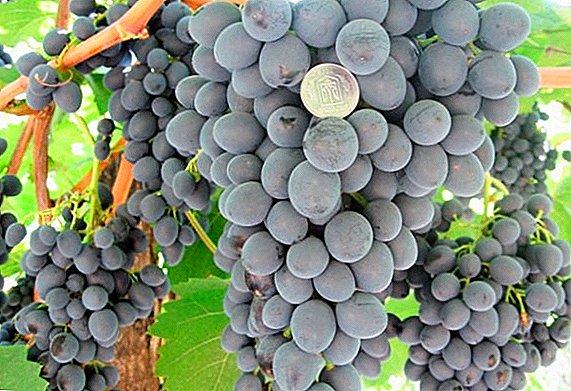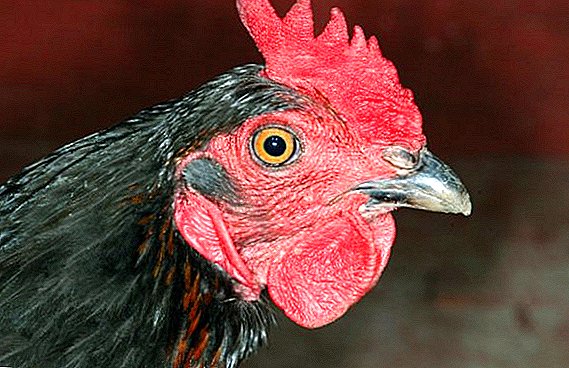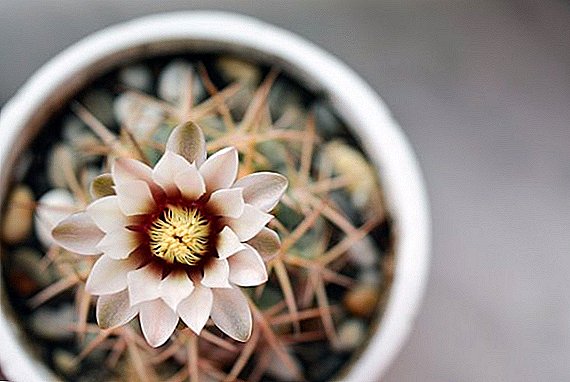 The unusual shape and simplicity of hymnocalycium made it one of the most common types of cacti. It is a spherical plant with curved spines, which can reach a height of 3 to 50 cm. The main feature of the hymnocalyucium is its ability to grow in any environment and adapt to different conditions.
The unusual shape and simplicity of hymnocalycium made it one of the most common types of cacti. It is a spherical plant with curved spines, which can reach a height of 3 to 50 cm. The main feature of the hymnocalyucium is its ability to grow in any environment and adapt to different conditions.
Main types
In general, there are about 70-100 species of hymnocalycium, of which only 15 are cultivated at home.
Did you know? Such a cactus is able to absorb not only the harmful radiation from electromagnetic devices, but also the negative emotions of people who are close to it.
- Gymnocalycium Andre (Gymnocalycium andreae) has a dark green stem of medium diameter (about 5 cm) of round shape. Flowering is observed at an early age in the form of light yellow inflorescences.

- Gymnocalycium naked (Gymnocalycium denudatum) is characterized by the presence of a spherical stem of a dark green color. Cactus can grow up to 15 cm in diameter and up to 20 cm in height. A distinctive feature of this type is the side shoots, which are formed on the sides at the bottom of the stem in the amount of 5-8 units. Flowers white color, less often - pale pink, large in size, located close to the crown.

- Gymnocalycium humpback (Gymnocalycium gibbosum) has a spherical bluish-green stem, whose height can reach 20 cm, diameter - 10 cm. Central prickles are observed in the amount of 1-2 units, radial - in the amount of 7-10 units. The flowers are white or pinkish, their length is about 6.5 cm.
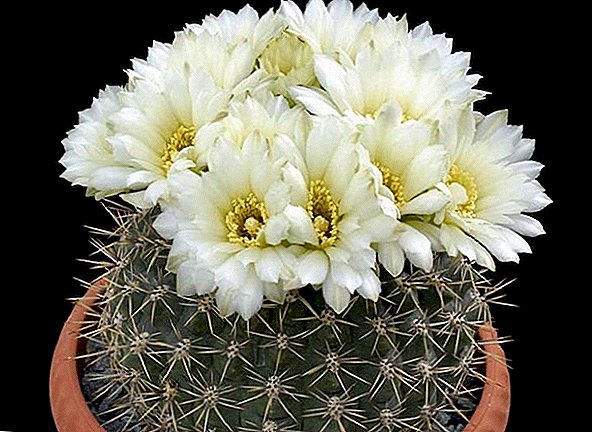
- Gymnokalikium Mikhanovich (Gymnocalycium Mihanovichii) is an artificially derived chlorophyll-free form of a cactus. The color of its flowers depends on the coloring particles: carotene and xanthophyll, giving, respectively, red and yellow shades. This type of hymnocalycium is not able to take root on its own roots, so it is grafted onto green varieties.
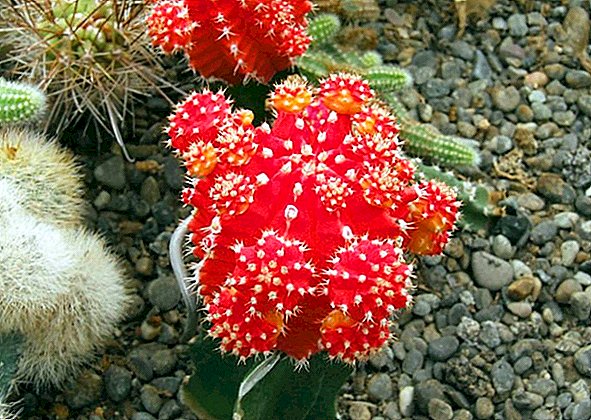
- Gymnocalycium Balda (Gymnocalycium baldianum) has a spherical shape and a bluish-green shade of the stem, which reaches 7 cm in diameter. The ribs are flat in shape, divided by grooves into wedge-shaped projections. The flowers of the plant grow 3-4 cm in size and have an unusual color for this species - purple-red.

Conditions and features of home care
Successful cultivation and reproduction of any type of hymnocalycium depends on the conditions in which it is placed.
Lighting
Cactus needs good lighting. Depending on the time of year, various nuances arise: light exposure should be carried out in the autumn and winter months, and in the spring-summer period, shading should be used to avoid burns on the plant.
Each type of cacti has its own preferences in care - zygocactus, opuntia, hatiora, epiphyllum.
Temperature
For hymnocalycium, it is recommended to adhere to room temperature at 20-24 ° C. In the autumn-winter period, it is necessary to reduce the air temperature to 15-18 ° C with a minimum figure of 5 ° C.
Watering
Gymnocalycium should be watered as the topsoil dries out in the spring and autumn period. From the beginning of autumn, watering should be reduced, and from the middle it should be drastically reduced.
Top dressing
Feed the plant preferably in the spring and summer every two to three weeks with special dressings for cacti, which contain useful mineral and organic substances. In autumn and winter, the cactus does not require fertilizer.
Important! Gymnocalycium should be fed only with mineral fertilizers, organic plants can die from organic fertilizers!
How to transplant at home: soil and pot
These plants do not need frequent transplantation because of the slow growth rate, it is best to do this once every 2-3 years. Young cacti can be transplanted annually, preferably in spring. It is necessary to choose a new pot so that it is a bit larger than the old one.
Transplant is performed as follows: the root system is carefully cleaned from the ground and dead parts, washed with hot water and left to dry for 2 days. After that, the plant can be placed in a new pot. The soil should contain leaf and sod land, peat and coarse sand. It is recommended to water it with acidified water.
Breeding methods
In hymnocalycium there are two ways of reproduction: seeds and lateral layers (children). Consider the distinctive features of each of them.
Seeds
This method is more reliable, since the probability of obtaining large and healthy offspring from seeds is much higher. The seed reproduction process is much longer and heavier than vegetative.
The main condition for this breeding method is the constant soil moisture in which the seeds are placed. The substrate for sowing can be chosen the same as for adult plants, but more fine-grained, having previously steamed it in the oven for disinfection.
The pot is desirable to take a small size with a shallow bottom. To maintain a constant moisture pot should be covered with a transparent lid. The ideal temperature for seed germination is 20 ° C. With the necessary light and heat, planting seeds can be done at any time of the year. Gymnocalyciums at a young age grow fairly quickly, and within a year they can be transplanted into separate pots.
Side layering
For hymnocalyciums, this method of reproduction is the fastest and easiest. The layers are separated from the parent stem, dried for a couple of days and then placed in a moist soil. Caring for cuttings is the same as for an adult plant, and does not require hassle.
If the lateral layer has its own roots that are connected to the root system of the mother plant, it must be carefully excavated and placed in a separate pot. It is advisable to combine this operation with transplanting the whole plant.
Did you know? Among all varieties of hymnocalycium, there are species that are completely devoid of chlorophyll. They are yellow, red and pink, but can only grow grafted on another green cactus.

Growing problems, pests and diseases
Gymnocalyciums are not fastidious in their essence, they adapt to various conditions and are resistant to pests. However, there are problems in growing this type of cactus, due to the following reasons:
- Wrong care.
- Use too hard water when watering.
- Alkaline soil in a pot plant.
- Damage to the stem during reproduction by lateral layers.
Red flat tongs and chervets are the main plant pests.
Rust stains indicate that the cactus settled red flat tick. This insect is very small, it is difficult to notice. Such a pest occurs mainly on young plants, since the skin of a mature cactus is too dense for it. The fight against ticks does not require much effort - you must rinse the stems under hot water or smear them with ethyl alcohol. Pesticides can be used as a last resort if the pest threatens the entire collection of cacti. Another pest, a mealybug, has a pinkish body and an air layer resembling cotton wool. Such an insect is located at the roots and on the stems of the plant, sucking all the juices out of it. You can get rid of the broom by washing the plant with hot water (but not boiling water) or by using insecticidal and universal preparations to kill the pest.
Another pest, a mealybug, has a pinkish body and an air layer resembling cotton wool. Such an insect is located at the roots and on the stems of the plant, sucking all the juices out of it. You can get rid of the broom by washing the plant with hot water (but not boiling water) or by using insecticidal and universal preparations to kill the pest.
Important! If you have noticed a cessation of growth of a cactus and the absence of flowers on it - this is a sure sign of the appearance of a mealy worm.Root rot is the main disease that can be tolerated by hymnocaliciums. The cause of the problem may be inappropriate soil for the plant, improper watering or poor temperature growing conditions. To get rid of rot, you should treat the roots with hot water and remove the affected areas. Healthy tissue must be sanitized with a mixture of crushed coal. A couple of days to dry the roots and return the plant to the soil.
With proper care for hymnocalycium, this plant can become not only a decoration of your interior, but also a guarantee of good health and mood. Growing this cactus does not require special skills, even a beginner can handle it, the main thing is to adhere to all the rules of lighting, watering and temperature control. As a result, you will admire the beautiful flowering of hymnocalycium, which amazes everyone with an incredible range of shades and unusual shapes.








